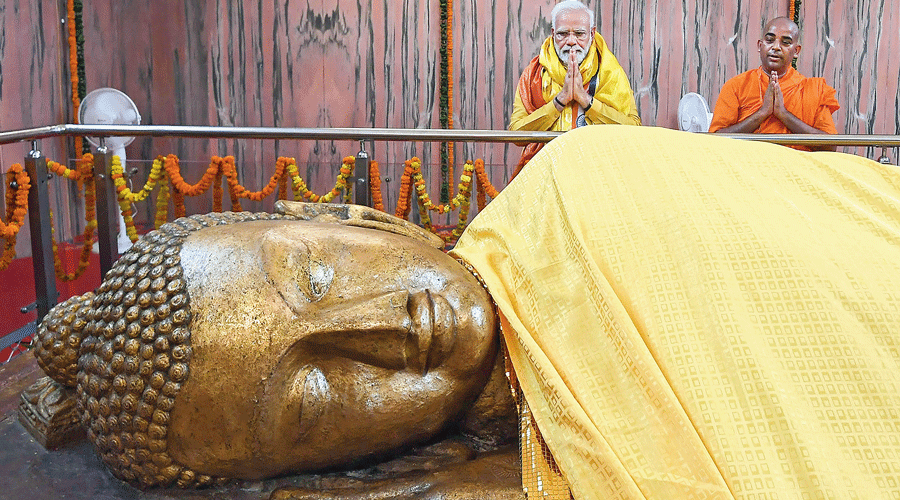Prime Minister Narendra Modi visited Lumbini in Nepal on Buddha Purnima, seeking to settle the controversy over the Buddha’s birthplace and create a footprint for India at one of Buddhism’s holiest places where China already has a head start.
Modi flew into Lumbini in a chopper from neighbouring Kushinagar in Uttar Pradesh and visited the Mayadevi temple, within which lies the Buddha’s birthplace, along with his Nepalese counterpart Sher Bahadur Deuba.
According to the external affairs ministry, the two leaders also visited the Ashoka Pillar, which “carries the first epigraphic evidence of Lumbini being the birthplace of Lord Buddha”.
Later, the two Prime Ministers participated in the shilanyas ceremony for an India International Centre for Buddhist Culture and Heritage at a plot in Lumbini that belongs to the New Delhi-based International Buddhist Confederation.
The centre is envisaged as a Net Zero Energy facility that will house prayer halls, a meditation centre, a library and an exhibition hall besides other amenities.
Several countries, including China, have already built monasteries in Lumbini. The Chinese Zhong Hua Monastery has been described by the travel guide, Lonely Planet, as one of the most impressive structures at Lumbini.
While the two premiers followed up on the conversation they had had in Delhi in April when Deuba visited India, the Lumbini visit is something Modi had expressed a desire to undertake since his first visit to Nepal in 2014.
On his three visits to the country since then (before the current trip), the Prime Minister visited key pilgrimage sites such as the Pashupatinath Temple in Kathmandu, Janaki in Janakpur and Muktinath in Mustang.
Nearly two years ago —when relations with Nepal were already strained — external affairs minister S. Jaishankar’s remark that Buddha was one of the “two greatest Indians ever” had upset Nepal, forcing India to swiftly clarify that there was no doubt about his birthplace being in Nepal.
During the bilateral meeting, the two sides agreed in principle to establish sister-city relations between Lumbini and Kushinagar —another holy site of Buddhism — acknowledging the two countries’ shared Buddhist heritage.
This apart, the deliberations focused on economy, trade, connectivity, energy and development partnership.
There was no official indication from either side whether the border issue came up during the talks. In the April meeting, Deuba had brought it up at the fag end of his media statement, saying they had discussed boundary issues and that he had urged Modi to resolve this through the establishment of a bilateral mechanism.
India maintains there are existing mechanisms for this, a point iterated by foreign secretary Vinay Mohan Kwatra during his briefing last Friday ahead of Modi’s visit.
“There are established bilateral mechanisms which exist between the two countries,” he had said.
“We have always maintained that they are the best way forward in discussing those issues, discussing in a responsible manner, without really politicis(ing) those issues. So, that is a subject which will essentially be in the scope of those established bilateral mechanisms.”
Differences between India and Nepal over their longstanding boundary issues had escalated during the tenure of Deuba’s predecessor K.P. Sharma Oli, resulting in Nepal changing its map in 2020 to include the disputed areas of Kalapani, Lipulekh and Limpiyadhura within its territory.










